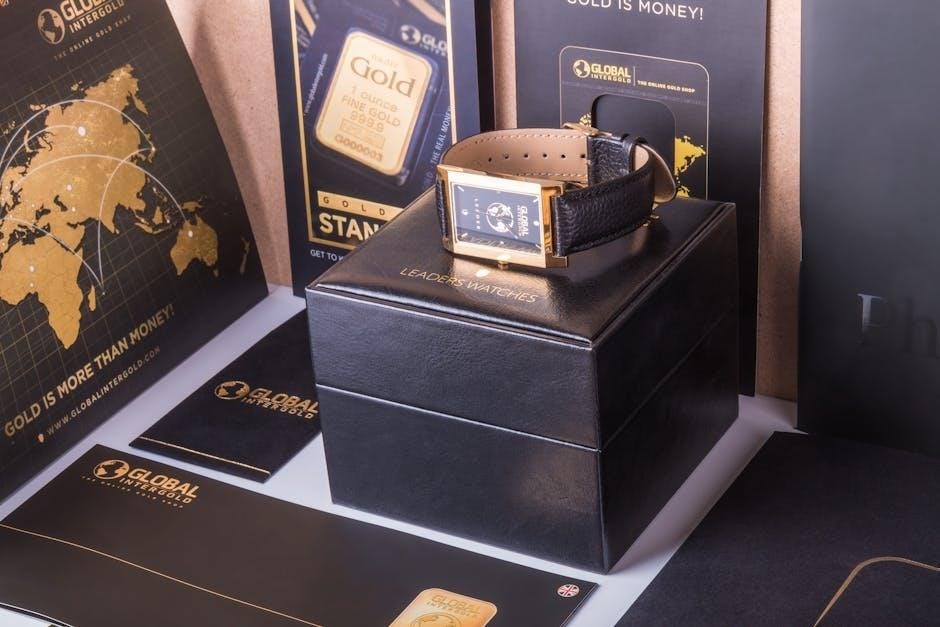Juliana Jewelry: Identification and Value Guide
This guide delves into the captivating world of Juliana jewelry, a sought-after vintage collection. We’ll explore methods for identifying authentic pieces and understanding the factors that influence their market value. Discover the allure and history behind these iconic designs.
Understanding DeLizza & Elster (Juliana) Jewelry
DeLizza & Elster, often referred to by collectors as “Juliana,” produced distinctive jewelry designs, originally identified only by paper hang tags attached to select pieces. This lack of permanent markings contributes to the challenge and excitement of identifying authentic Juliana creations. Their jewelry is celebrated for its elaborate designs, vibrant colors, and use of high-quality rhinestones and art glass stones.
The company was known for its secretive practices, rarely signing their work directly, which added to the mystery. This has led to collectors assigning the “Juliana” moniker, creating a unique niche in the vintage jewelry market. Understanding the construction techniques, stone settings, and design elements unique to DeLizza & Elster is crucial for accurate identification. Recognizing these characteristics allows enthusiasts to appreciate the artistry and craftsmanship of this beloved vintage jewelry.
Their diverse range includes brooches, necklaces, bracelets, and earrings, each reflecting the bold and glamorous styles of the mid-20th century.

Identifying Juliana Jewelry
Identifying Juliana jewelry requires a keen eye and knowledge of specific characteristics. Look for unique construction techniques, stone settings, and design elements that distinguish these pieces. Examining the back of the jewelry is often key.
Key Identification Characteristics
Identifying authentic Juliana jewelry involves recognizing several distinct characteristics. Since DeLizza & Elster pieces weren’t consistently marked, identification relies on construction and design details. Begin by carefully examining the back of the piece. Look for the “five-link and band” construction often found in bracelets, a telltale sign of Juliana design. The use of glue to affix stones, especially larger ones, is another important indicator.
Genuine Juliana pieces frequently feature a combination of different stone shapes, sizes, and colors within the same design. This eclectic mix is part of their charm. The overall design often displays an elaborate and layered aesthetic, showcasing intricate craftsmanship. Examine the metalwork for specific characteristics associated with DeLizza & Elster.
Remember that identifying Juliana jewelry can be challenging, and consulting reference materials is crucial. Websites dedicated to Juliana jewelry and reference books can provide invaluable insights and comparisons. Look for overlapping prongs and puddling of solder. However, experience and careful observation are the best tools for spotting authentic Juliana pieces.
Five-Link and Band Bracelet Construction
A key identifier for Juliana bracelets is their unique five-link and band construction. This specific design element is a hallmark of DeLizza & Elster’s craftsmanship during the Juliana era. When examining a bracelet, carefully inspect the way the links are connected. The five-link component refers to a distinct arrangement where five individual links are joined together to form a segment of the bracelet.
This segment is then typically connected to a wider, more decorative band, creating a visually appealing and structurally sound piece. This combination of five-link segments and a broader band distinguishes Juliana bracelets from other vintage jewelry. Not all Juliana bracelets will have this, but it is a common feature.
Turning the bracelet over and observing this particular type of linking can be a straightforward way to potentially identify a piece as Juliana. However, always consider other identifying characteristics in conjunction with the five-link and band construction. The presence of this construction detail should be viewed as one piece of evidence within a comprehensive assessment.
Glue Affixed Stones
One of the most telling characteristics of genuine Juliana jewelry is the presence of stones that are affixed with glue, rather than solely relying on prong settings. While some stones may also have prongs for added security, the use of glue as a primary or supplementary method of attachment is a common trait.
This technique was employed by DeLizza & Elster during the manufacturing of Juliana jewelry to secure stones of various shapes, sizes, and materials. When examining a piece, carefully inspect the areas around the stones. Look for visible traces of glue, which may appear as a hardened residue or a slight discoloration around the edges of the stones.
Keep in mind that over time, the glue may have deteriorated or become less noticeable. However, the presence of glue, even in small amounts, can be a significant indicator. This characteristic, combined with other identifying features, can help determine if a piece is likely a Juliana creation. Be aware that restoration and repair over the years can cause this to be absent.
Using Online Databases for Identification
In the digital age, identifying Juliana jewelry has become significantly easier thanks to the availability of online databases specifically dedicated to DeLizza & Elster designs. These databases serve as invaluable resources for collectors and enthusiasts seeking to authenticate and learn more about their pieces.
One notable resource is the website isitjulianajewelry.com, hosted by recognized experts in the field. This website allows users to search for specific traits, such as color, stone type, and jewelry type, to find potential matches within its extensive database of verified Juliana pieces.
By comparing the characteristics of your jewelry with the information and images available in these databases, you can gain valuable insights into its potential origin and design. However, it is important to remember that online databases should be used as a tool to increase information and should not be the sole basis for identification. Always cross-reference information and consult with experienced collectors or appraisers for expert opinions.
Juliana Jewelry Reference Resources
Explore key resources for Juliana jewelry identification. We’ll cover books and websites, providing valuable information. These tools will aid collectors in authenticating and understanding their cherished pieces.
Ann Pitman’s “Juliana Jewelry Reference, DeLizza & Elster: Identification & Price Guide”
Ann Pitman’s comprehensive “Juliana Jewelry Reference, DeLizza & Elster: Identification & Price Guide” is an essential resource for both novice and experienced collectors. This book showcases a vast array of vintage jewelry designs from DeLizza & Elster, commonly known as Juliana.
The guide offers a searchable list of verified Juliana pieces, categorized by jewelry type, color, and stone type, enabling users to easily locate specific items. It provides detailed information and photos, assisting in the identification process.
Collectors can find information about chains, stones, and other identifying characteristics. Pitman’s reference book serves as a valuable tool for understanding the nuances of Juliana jewelry and determining its potential value. This guide helps collectors to distinguish authentic Juliana pieces from imitations, ensuring informed collecting decisions.
Its detailed descriptions and pricing insights make it an indispensable addition to any Juliana enthusiast’s library.
IsItJulianaJewelry.com Website
IsItJulianaJewelry.com is a dedicated online resource that aids in the identification of DeLizza & Elster jewelry, known popularly as Juliana. This website, hosted by Wacker and Knutson, offers a searchable database to help users identify DeLizza & Elster designs by inputting specific traits.
The website helps collectors identify Juliana jewelry. The site allows users to search for specific characteristics. This database is particularly useful for those seeking to confirm the authenticity of a piece based on design elements, stone types, and construction techniques.
By providing a platform to compare jewelry pieces against a comprehensive catalog of verified Juliana designs, IsItJulianaJewelry.com empowers collectors to make informed decisions. The website is a valuable tool for both novice and experienced collectors, offering a user-friendly interface and detailed information to assist in the identification process.
It is an essential resource for anyone passionate about collecting Juliana jewelry.

Determining the Value of Juliana Jewelry
Determining the value of Juliana jewelry involves considering several key factors. Scarcity plays a significant role, with rarer designs and color combinations commanding higher prices. The condition of the piece is also crucial; jewelry in excellent condition, free from damage or wear, will be more valuable.
Desirability among collectors is another important aspect. Certain Juliana styles and sets are more sought after than others, influencing their market value. The presence of original stones and embellishments, as well as the overall craftsmanship, contribute to the perceived worth of the jewelry.
Provenance, or the history of ownership, can also impact the value, especially if the piece has a documented connection to a notable collection or event. Market trends and the current demand for vintage jewelry in general also influence Juliana jewelry prices.
Consulting price guides, auction records, and experienced appraisers can provide valuable insights into the current market value of specific Juliana pieces.

Hallmarks and Signatures
Notably, Juliana jewelry rarely features traditional hallmarks or signatures directly on the pieces. This absence is a key characteristic, distinguishing it from other vintage jewelry brands that commonly used stamped markings.
The Absence of Traditional Markings
One of the defining characteristics of Juliana jewelry, manufactured by DeLizza & Elster, is the general lack of traditional hallmarks or signatures directly on the pieces themselves. Unlike many other vintage jewelry designers who prominently stamped their brand names or logos onto their creations, DeLizza & Elster primarily relied on paper hang tags to identify their Juliana line. These paper tags, unfortunately, were often detached and lost over time, making the identification process more challenging for collectors today.
This absence of permanent markings was a deliberate choice by DeLizza & Elster, perhaps to reduce production costs or to allow retailers to market the jewelry under their own store brands. Whatever the reason, it has contributed to the mystique and collectibility of Juliana jewelry.
The lack of markings means that collectors must rely on other identifying features, such as construction techniques, stone settings, and design motifs, to authenticate a piece as genuine Juliana. Reference materials, like Ann Pitman’s “Juliana Jewelry Reference,” and online databases, such as isitjulianajewelry.com, are essential tools for navigating this identification process.

Types of Juliana Jewelry
Juliana jewelry, produced by DeLizza & Elster, encompasses a diverse range of styles and designs, reflecting the fashion trends and aesthetic preferences of the mid-20th century. Collectors can find Juliana pieces in various forms, each showcasing the brand’s signature craftsmanship and attention to detail.
Brooches are a prominent category, often featuring intricate floral motifs, abstract designs, and figural representations. Necklaces range from delicate pendants to bold statement pieces, incorporating colorful rhinestones, art glass stones, and elaborate metalwork. Bracelets are particularly popular among collectors, with the five-link construction being a hallmark of many Juliana designs.
Earrings, available in clip-on and pierced styles, complement the necklaces and brooches, completing the ensemble. Ring designs vary from simple solitaire settings to multi-stone clusters, often showcasing unusual gemstone cuts and vibrant color combinations. Beyond these core categories, Juliana also produced dress clips, belts, and other fashion accessories, further expanding the scope of their creative output. The variety ensures there’s a Juliana piece for every taste.




Be the first to reply